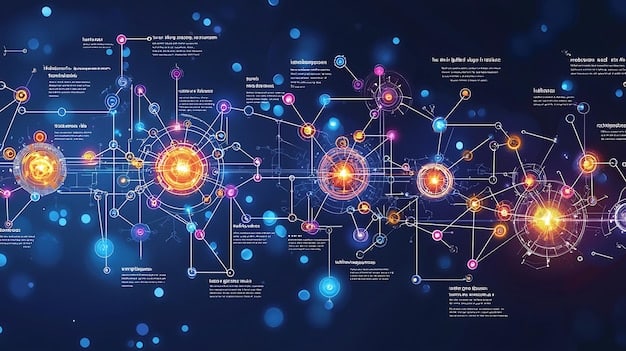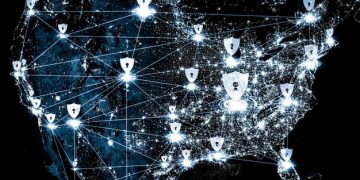AI Cybersecurity Threats to US Businesses in 2025: What to Expect

In 2025, US businesses face new cybersecurity threats from AI, including sophisticated phishing attacks, AI-driven malware, and the manipulation of AI systems, necessitating advanced defense strategies.
The landscape of cybersecurity is constantly evolving, and as we approach 2025, the rise of artificial intelligence (AI) introduces both opportunities and significant challenges. Understanding what new cybersecurity threats will AI pose to US businesses in 2025 is crucial for proactive defense strategies. This article delves into the potential dangers and how businesses can prepare.
Understanding the Evolving Threat Landscape
The cybersecurity landscape is undergoing a massive transformation, primarily driven by advancements in artificial intelligence. Traditional security measures are increasingly challenged by AI-powered threats that can adapt and learn, making them more difficult to detect and neutralize. Understanding these changes is essential for US businesses to stay ahead of potential attacks in 2025.
The Role of AI in Cybersecurity
Artificial intelligence plays a dual role in cybersecurity. On one hand, it offers powerful tools for threat detection, automated response, and predictive analysis. On the other hand, it can be exploited by malicious actors to create more sophisticated and effective cyberattacks. This duality requires a comprehensive understanding of AI’s capabilities and potential vulnerabilities.
- AI-driven threat detection systems can analyze vast amounts of data to identify anomalies and potential threats in real-time.
- Automated response systems can quickly neutralize threats, reducing the impact of cyberattacks.
- Predictive analysis uses machine learning to anticipate future threats and vulnerabilities.

The sophistication of AI-powered attacks is rapidly increasing. By 2025, US businesses can expect to see more sophisticated phishing campaigns, AI-driven malware, and attacks that target AI systems themselves. Preparing for these evolving threats requires a multifaceted approach that includes advanced technology, employee training, and robust security policies.
AI-Powered Phishing Attacks
Phishing attacks are one of the most common and successful methods used by cybercriminals. With the help of AI, these attacks are becoming more sophisticated and harder to detect. In 2025, AI-powered phishing attacks will pose a significant threat to US businesses.
AI algorithms can analyze vast amounts of data to create highly personalized and convincing phishing emails. These emails can mimic the writing style of trusted contacts, making them more likely to bypass traditional security filters. The use of AI also allows attackers to automate the phishing process, targeting a larger number of individuals with greater precision.
How AI Enhances Phishing Attacks
- AI algorithms analyze social media profiles and other online sources to gather information about potential victims, allowing attackers to create highly personalized phishing emails.
- Natural language processing (NLP) enables attackers to craft emails that mimic the writing style of trusted contacts, making them more convincing.
- AI-powered chatbots can engage with victims in real-time, extracting sensitive information through conversational interactions.
To protect against these advanced phishing attacks, US businesses need to implement multi-layered security measures. These measures should include advanced email filtering, employee training, and the use of AI-powered threat detection systems. Regularly testing employees with simulated phishing attacks can also help to identify vulnerabilities and improve awareness.
Furthermore, businesses should encourage employees to verify the authenticity of emails and phone calls, especially those requesting sensitive information. Implementing two-factor authentication (2FA) can add an extra layer of security, making it more difficult for attackers to gain access to sensitive accounts.
AI-Driven Malware
Malware, or malicious software, poses a persistent threat to businesses of all sizes. AI is now being used to create more sophisticated and evasive malware that can adapt to security defenses in real-time. In 2025, AI-driven malware will be a major concern for US businesses.
Traditional malware detection methods rely on identifying known signatures and patterns. AI-driven malware can evolve and mutate to avoid detection, making it much harder to defend against. These advanced malware programs can also learn from previous attacks, adapting their behavior to maximize their effectiveness.
One of the key features of AI-driven malware is its ability to automate many of the tasks traditionally performed by human attackers. This includes vulnerability scanning, exploit selection, and payload delivery. By automating these processes, AI-driven malware can launch attacks more quickly and efficiently.
Defending Against AI-Driven Malware
Defending against AI-driven malware requires a proactive and adaptive security strategy. Businesses need to implement advanced threat detection systems that can identify anomalous behavior and suspicious activities. These systems should be powered by AI and machine learning algorithms that can learn from new threats and adapt to evolving attack patterns.
- Implement endpoint detection and response (EDR) solutions that can monitor endpoint devices for malicious activity and provide real-time alerts.
- Use network traffic analysis (NTA) tools to identify unusual patterns and anomalies in network traffic.
- Regularly update security software and operating systems to patch vulnerabilities and prevent exploitation.
In addition to technology, employee training is critical for preventing AI-driven malware attacks. Employees should be trained to recognize phishing emails and other social engineering tactics. They should also be educated about the risks of downloading software from untrusted sources and the importance of following security best practices.
By combining advanced technology with employee training and robust security policies, US businesses can mitigate the risk of AI-driven malware attacks in 2025.
Manipulating AI Systems
As businesses increasingly rely on AI systems for critical operations, the risk of attackers manipulating these systems becomes a significant concern. In 2025, US businesses will need to be aware of the potential for AI manipulation and take steps to protect their AI infrastructure.
AI systems are vulnerable to a range of attacks, including adversarial attacks, data poisoning, and model theft. Adversarial attacks involve crafting inputs that cause AI systems to make incorrect predictions. Data poisoning involves injecting malicious data into the training data, compromising the accuracy and reliability of AI models. Model theft involves stealing or reverse engineering AI models for malicious purposes.

Protecting AI Systems from Manipulation
Protecting AI systems from manipulation requires a multi-faceted approach that includes secure development practices, robust access controls, and continuous monitoring. Businesses should implement secure coding practices to prevent vulnerabilities in their AI systems. They should also enforce strict access controls to limit who can access and modify AI models and data.
- Implement robust authentication and authorization mechanisms to control access to AI systems and data.
- Use data validation and sanitization techniques to prevent data poisoning attacks.
- Monitor AI systems for anomalous behavior and unexpected predictions.
Another important aspect of protecting AI systems is to develop robust testing and validation procedures. AI models should be rigorously tested to ensure that they are accurate, reliable, and resistant to adversarial attacks. Businesses should also conduct regular security audits to identify vulnerabilities and potential weaknesses in their AI infrastructure.
By taking these steps, US businesses can reduce the risk of AI manipulation and ensure the integrity and reliability of their AI systems in 2025.
Insider Threats and AI
While external threats often dominate cybersecurity discussions, insider threats pose a significant risk to US businesses. AI can exacerbate insider threats by providing malicious insiders with more powerful tools and techniques. In 2025, businesses will need to be particularly vigilant about the potential for AI-enhanced insider attacks.
Malicious insiders can use AI to automate tasks, bypass security controls, and exfiltrate sensitive data. They can also use AI to identify vulnerabilities in systems and exploit them with greater precision. The combination of human knowledge and AI capabilities can make insider attacks particularly difficult to detect and prevent.
Mitigating AI-Enhanced Insider Threats
Mitigating AI-enhanced insider threats requires a combination of technical and organizational measures. Businesses need to implement robust access controls to limit who can access sensitive data and systems. They should also monitor employee behavior for suspicious activities and enforce strict security policies.
- Implement least privilege access controls to ensure that employees only have access to the data and systems they need to perform their job duties.
- Use user and entity behavior analytics (UEBA) to detect anomalous behavior and identify potential insider threats.
- Conduct regular security awareness training to educate employees about the risks of insider threats and how to report suspicious activity.
In addition to these measures, businesses should also implement strong data loss prevention (DLP) policies to prevent sensitive data from being exfiltrated. DLP systems can monitor network traffic and endpoint devices for unauthorized data transfers and block suspicious activity. By combining these measures, US businesses can reduce the risk of AI-enhanced insider attacks in 2025.
The human element remains critical in detecting insider threats. Encourage a culture of transparency and trust, where employees feel comfortable reporting suspicious behavior without fear of reprisal. Implement whistleblower programs and ensure that reports are investigated promptly and thoroughly.
The Role of Regulation and Compliance
As AI becomes more prevalent in cybersecurity, regulatory and compliance requirements are likely to evolve. In 2025, US businesses will need to stay abreast of new regulations and ensure that their security practices comply with applicable laws and standards.
Several existing regulations, such as the California Consumer Privacy Act (CCPA) and the General Data Protection Regulation (GDPR), already impose strict requirements for data protection and cybersecurity. These regulations are likely to be expanded to address the unique challenges posed by AI. Businesses will need to ensure that their AI systems comply with these regulations and that they have adequate safeguards in place to protect sensitive data.
Preparing for New Regulations
Preparing for new regulations requires a proactive and adaptable compliance strategy. Businesses should monitor regulatory developments and engage with industry groups to stay informed about emerging requirements. They should also conduct regular risk assessments to identify potential gaps in their compliance program.
- Stay informed about regulatory developments and engage with industry groups.
- Conduct regular risk assessments to identify potential compliance gaps.
- Implement a comprehensive compliance program that addresses all applicable regulations and standards.
In addition to complying with existing regulations, businesses should also consider adopting industry best practices for AI security. Organizations such as the National Institute of Standards and Technology (NIST) and the Center for Internet Security (CIS) have developed guidelines and frameworks for securing AI systems. By following these best practices, US businesses can enhance their security posture and reduce the risk of cyberattacks in 2025.
Furthermore, businesses should invest in technologies and processes that support regulatory compliance. This includes tools for data governance, access control, and security monitoring. Automation can play a key role in streamlining compliance efforts and reducing the burden on IT staff.
Conclusion
In conclusion, the cybersecurity landscape in 2025 will be significantly shaped by artificial intelligence. US businesses must prepare for new and evolving threats, including AI-powered phishing attacks, AI-driven malware, and the manipulation of AI systems. By implementing advanced security measures, investing in employee training, and staying abreast of regulatory developments, businesses can mitigate the risks and protect their assets in the AI era. Proactive defense and continuous adaptation are crucial for maintaining a strong security posture in the face of these emerging challenges.
| Key Point | Brief Description |
|---|---|
| 🛡️ AI-Powered Phishing | Sophisticated phishing emails mimic trusted sources using AI. |
| 🦠 AI-Driven Malware | Malware adapts to security defenses via AI. |
| 🤖 AI System Manipulation | Attacks target AI models through data poisoning and theft. |
| 🕵️ Insider Threats & AI | Malicious insiders use AI to extract data. |
FAQ
▼
The primary threats include AI-enhanced phishing, AI-driven malware that adapts to defenses, and manipulation of AI systems through adversarial attacks and data poisoning.
▼
AI can analyze social media, mimic writing styles, and automate personalized emails, making phishing attempts more convincing and increasing the chances of success.
▼
Businesses should implement advanced threat detection systems, use endpoint detection and response solutions, and keep security software updated to defend against adaptive malware.
▼
Protect AI systems with robust access controls, data validation, anomaly monitoring, and rigorous testing to prevent adversarial attacks and data poisoning.
▼
Compliance with regulations like CCPA and GDPR is essential, along with staying updated on new AI-specific regulations and adopting industry best practices for AI security.
Conclusion
As we look towards 2025, the intersection of AI and cybersecurity presents both challenges and opportunities for US businesses. Staying informed, implementing robust security practices, and embracing a proactive approach are essential for navigating this evolving landscape effectively.





